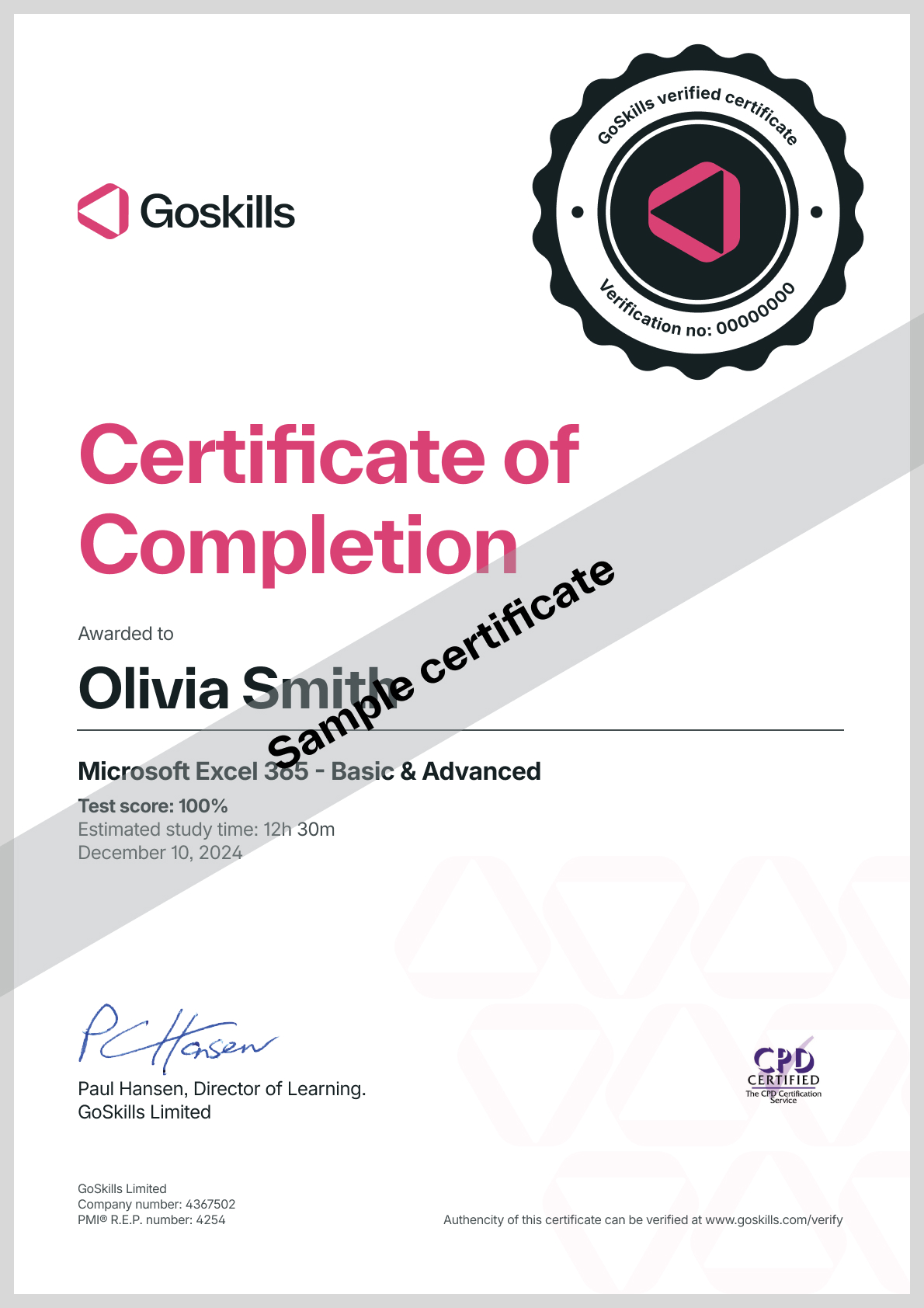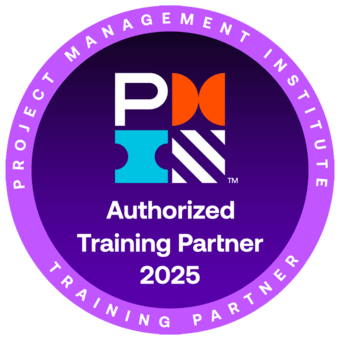Project Management for Engineers
Project Management for Engineers
Skills you’ll gain
Do you manage projects, or want to enter a new project management role? This online course is ideally suited for engineers looking to better manage their projects for work. It is also suited for project managers, business owners, or those looking to start out in project management.
In 45 engaging lessons, you will learn how to effectively manage projects from start to finish through a range of topics including scope, schedule and resource planning, project risk, execution and control plus more.
Highlights:
- Learn to manage your projects more effectively.
- Get a better understanding of project management principles.
- Based on The Project Management Institute, A Guide to the Project Management Body of Knowledge (PMBOK® Guide) - Seventh Edition, Project Management Institute, Inc., 2021.
- Use this as a stepping stone to embark on a project management career.
- Earn 23 PDUs or contact hours toward your Project Management education for certification with PMI.
If you’re looking for something more in-depth, try our courses on Project Management Framework, Project Teams and Stakeholders, Project Planning, or Project Performance and Delivery. And if you’re preparing for the PMP Exam, consider PMP® Certification Training.
Once enrolled, our friendly support team and tutors are here to help with any course-related inquiries.
Syllabus
Download syllabus-
1
Project Boundaries Learn how to quickly identify project boundaries using the W questions. 5m
-
2
In-Frame/Out-of-Frame In-Frame/Out-of-Frame is a technique for clarifying project boundaries by listing both the activities and deliverables that are in scope for the project and listing the activities that are not required as part of the project. 4m
-
3
Stakeholders The Project Stakeholders' support is essential for project success. Project Stakeholders set the goals for the project and will ultimately determine whether the project is considered a success or failure. 4m
-
4
Project Leader The Project Leader is responsible for ensuring the project team executes the project. 6m
-
5
Core Team Most large projects are managed by a cross-functional core team. Core team members have a dual responsibility; they are responsible for the project achieving its goals and they are responsible to ensure that the project complies with their function’s standards and best practices. 6m
-
1
Primary Constraint The approach taken when planning a project should be based upon the primary project constraint. Attributes of that constraint are planned first and then other aspects of the project are planned to support the primary constraint. 4m
-
2
Project Phases Projects are often organized into phases. Phases provide structure and logic to the project and aid the project team and management to track progress. 6m
-
3
Progressive Elaboration Progressive elaboration is the principle of steadily adding detail to the project plan as more information becomes available. 5m
-
4
Project Deliverables Learn how to identify project tasks and activities using the deliverables deployment technique. 4m
-
5
Task Description Task Descriptions are the statements of scope for each of the project activities. They are written in the format of “action – completion point.” 3m
-
6
WBS Dictionary The WBS Dictionary is a table or spreadsheet that is organized by project task and contains all project planning details. 4m
-
1
Milestone Schedule Understand when and how to use a milestone schedule on a project. Learn how to create a milestone schedule. 3m
-
2
Gantt Chart Understand when and how to use a Gantt chart on a project. Learn how to create a Gantt chart. 6m
-
3
Task List Schedule A Task List Schedule is a schedule format used to communicate tasks with dates to extended team members or those who do not have a major role in the project. 3m
-
4
Kanban Schedule A Kanban Schedule is a project scheduling tool for managing a batch of similar items that must be processed through the same project steps. 5m
-
5
Network Diagram A network diagram is a project scheduling technique that shows the relationship between tasks by depicting project activities as a flowchart. 5m
-
1
Project Budget Understand what is normally shown in a project budget. Learn how to create a time-phased project budget. 6m
-
2
Responsibility Matrix The Responsibility Matrix is a project management tool for correlating project work assignments with project team members. 3m
-
1
Estimating Uncertainty Project plans are built with an accumulation of estimates, each of which has a level of uncertainty associated with it. The level of uncertainty is a major contributor to the accuracy of the plan and the amount of project risk. 5m
-
2
Estimating Techniques The most commonly used techniques for creating project estimates are analogous estimates, bottom-up estimates, three-point estimates, and using a parametric model. 5m
-
3
Effort-Duration-Money Project estimates of effort, duration, and money are interrelated. Based upon the cost and availability of the resources involved, once you have one of the estimates, you can derive the other two. 5m
-
4
Time Box Time Boxes are an estimating technique that sets a finite time for a task or task group. The amount of scope that is completed is variable. Whatever scope is done when the time box ends is the amount of scope for that activity on the project. 4m
-
1
Positive and Negative Risk Understand the difference between positive and negative risk. Learn the major steps of project risk management. 5m
-
2
Risk Identification Risk Identification is the practice of identifying positive and negative conditions that may occur within the project and impact project objectives. 5m
-
3
Negative Risk Response Negative Risk Response is determining what actions the project will take to address risk threats. 6m
-
4
Positive Risk Response Positive Risk Response is determining what actions the project will take to address risk opportunities. 5m
-
5
Contingency and Triggers Contingencies are potential risk response actions that will only be implemented if some triggering event or condition has shown that the risk probability has gone from unlikely to likely. 4m
-
1
Team Building Project Team Building is a process that the Project Core Team normally goes through to improve team coordination and decision making. 4m
-
2
Communication Management Project Communication Management is a very broad term that refers to all of the communication activities associated with the project. Communication is a key attribute of project management. 4m
-
3
Task Accountability Task Accountability is the project management activity associated with ensuring the successful completion of project activities. 5m
-
4
Quality Control - Quality Assurance Quality management on projects are processes and tools that aid the project core team and the organization in their effort to both do the right things and do things the right way on projects. It includes a focus on both corrective actions and preventive actions. 7m
-
5
Contractor and Vendor Execution Contractors and vendors are often used to accomplish project tasks. The complexity, uniqueness, and uncertainty of the activity will determine the nature of the relationship between the project team and the contractor or vendor. 5m
-
1
Project Dashboards Learn how to create and use a project dashboard to communicate project status with both management and your project team. 4m
-
2
Management Meetings Project Management Reviews are the formal documented meetings held periodically between senior management and the project team. 4m
-
3
Technical Reviews Project technical reviews are formal decision meetings between team members and a panel of subject matter experts. 4m
-
4
Scope Creep Scope creep is the uncontrolled expansion to project scope without adjustments to time, cost, and resources. 5m
-
5
Issue Resolution Issues are any request, complaint, or unexpected condition that leads to unplanned, but in scope, work that must be accomplished on a project. They normally result in the need to implement a workaround in order to resolve them. 4m
-
6
Project Change A formal documented modification to the project baseline, boundaries, or an artifact. 6m
-
1
Stakeholder Acceptance Understand how to gain stakeholder acceptance during project closeout and learn how to create and use a Punch List. 5m
-
2
Transition to Business To fully realize the benefit of a project, often business systems need to change to implement the project results. This transition can be a challenging aspect of the project. 5m
-
3
Lessons Learned Lessons Learned are a retrospective look at a project, or phase of a project, to identify best practices to be repeated and performance gaps to be improved. 4m
Certificate
Certificate of Completion
Awarded upon successful completion of the course.

Instructor
Ray Sheen
Ray is a certified Project Management Professional (PMP) with the Project Management Institute, a certified Scrum Master with Scrum Alliance, and certified Lean Six Sigma Black Belt with IASSC. He is a member of the Project Management Institute and the Product Development Management Association.
He is president and founder of Product & Process Innovation, Inc. and is a veteran business leader with over 25 years of executive, project management, and engineering management experience. Ray has worked in several industries including aerospace, electrical distribution and utilities, biotechnology, appliances, electronics, machining, medical devices, pharmaceutical, automotive, and financial services. He has held executive management positions in a Fortune 500 company and has been involved in entrepreneurial startup organizations.

Ray Sheen
Project Management Instructor & Author
Accreditations
Link to awards The PMI ATP seal, PMI, PMP, CAPM and PMBOK are registered marks of the Project Management Institute, Inc.How GoSkills helped Chris
I got the promotion largely because of the skills I could develop, thanks to the GoSkills courses I took. I set aside at least 30 minutes daily to invest in myself and my professional growth. Seeing how much this has helped me become a more efficient employee is a big motivation.



